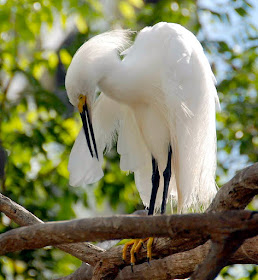
One of my favorite parks for walking is Lake Ashby Park in Volusia County. Most days it is virtually deserted and one can get a taste of several different ecosystems from the relative comfort of a boardwalk, long bridge, and forest walk . . . all without having to do any heavy hiking.

While it was cooler today (mid 80°s F. ; 29° C.) it was still plenty buggy and the sun was still burning hot on my face.
This part of Florida is subtropical, located in a transition zone between the tropics and more temperate regions to our north. The term "subtropical" in ecology describes the climatic region found adjacent to the tropics, usually between 23.5 and 40 degrees of latitude in both hemispheres (we're located at about 28.5° N., deep into the subtropics).
A subtropical region has at least eight months per year of mean temperatures 50° F. (10° C.) or higher. In this subtropical region the winters are relatively mild and palm trees are the most obvious difference from mid-latitude forests. . .but we still have deciduous and coniferous trees mingled in with scrub palms and other tropical flora making it, as I said, a transitional zone. As one walks through the forest it is easy to see the patches of hardier trees which are changing colors just as they do at higher latitudes.

It was still warm enough for the Yellow-bellied sliders (Trachemys scripta scripta) to gather in large numbers on anything floating in the virtually dry swamps. One would never know that it had rained -- at last -- only a week ago. Below: I count 21 sliders on that log.

The trees are alive with various wading birds already moved in for the southern winter. Below: A Snowy Egret (Egretta thula).

The low sun angle of Fall makes it appear that there is fog in the forest. More likely it is dust or bugs that catch the light.
Tomorrow the sun altitude will reach only 52.9°, far lower than its height last June (of 84.7°). The lower angle of the sun makes for much longer shadows and some really interesting light in the forests.
The sun has a bit further south to travel before we see our lowest sun angles in December. On December 20th the angle will only reach 38°, despite the fact that we're located deep in the subtropics.
CALCULATE THE SUN ANGLE AT YOUR LATITUDE using the easy form at Sun or Moon Altitude/Azimuth Table a courtesy of the U.S. Navy.

Below: On the forest floor an Old Man of the Woods (Strobilomyces strobilaceus). This fungus appears between August and November, normally at higher elevations than our 6' above sea level. Young specimens are edible.

Along the bridge-board walk one can see many Great Egrets (Ardea alba) and Great Blue Herons wading and fishing in the very shallow waters.

Great Blue Herons are excellent fishermen. Ask any gardener who has attempted to raise koi in this area.


Above and Below: Great Blue Herons (Ardea herodias).

Below: More interesting light through some large Live Oaks (Quercus virginiana) on the higher, dry land.

On the trees there are many squirrels (Eastern Gray Squirrel; Sciurus carolinensis).

Looking closer at the water dragonflies are abundant. Here a couple engage in coitus. Dragonflies are in the order Odonata, suborder Epiprocta.

Some more rare visitors to the wetlands are the Black-crowned Night heron (Nycticora nycticorax). At the bottom left of this image a little slider is sticking his head out of the water.

Below: On a twig a Black Swallowtail caterpillar (Papilio polyxenes) starting to pupate.

No comments:
Post a Comment